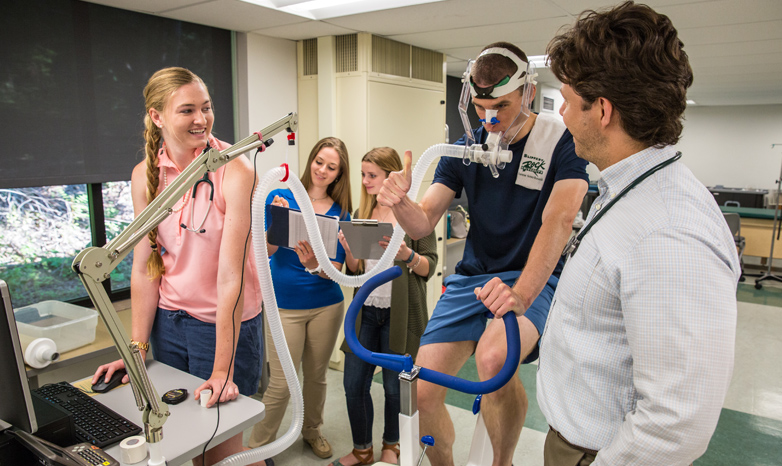SRU students conducting elaborate blood pressure study

SRU exercise science majors Melanie Clark, Maureen Walsh and Sarah Allen record exercise and heart rate readings of a participant in their study that measures the effects of exercise duration on inter-arm blood pressure difference.
July 18, 2017
SLIPPERY ROCK, Pa. - When freshmen arrive at Slippery Rock University, it's only natural that they have questions - lots of them.
But it was one question asked more than three years ago that has led to an elaborate study at SRU involving 100 participants and more than $10,000 in combined grants.

HOLMSTRUP
It all started when then-freshman Melanie Clarke, now a senior exercise science major from Pipersville, asked her professor and adviser, Michael Holmstrup, assistant professor of exercise and rehabilitative sciences, a simple question: "Which arm do you use to measure blood pressure?"
Holmstrup explained that it's mostly based on convenience but he had read research that if there is a significant difference in the blood pressure between arms that it could be a marker of health risks. Clarke continued to ask more questions, especially when she discovered that none of the research to date had considered blood pressure difference during exercise.
"That was our eureka moment when we came up with it," said Clarke, who came to SRU as an aspiring physical therapist before finding a new ambition: becoming a research professor. "It completely changed my college experience. Getting involved with research, I started rethinking everything about my education and what I want to do."
After conducting a pilot study two years ago, Clarke and Holmstrup are continuing the research this summer as part of a study in the University's Exercise and Rehabilitative Sciences Department. The pair are measuring the effects of exercise duration on inter-arm blood pressure difference, or "ISBPD" as it is referred to in the lab.
Clarke received a $725 Summer Undergraduate Research Experience grant to examine the response to exercise with people who don't have ISBPD at rest, while Maureen Walsh, a senior exercise science major from Hermitage, received a separate $725 SURE grant to study the response to exercise for people who have ISBPD at rest.
The research was also funded by faculty student research grants, state grants and a technology grant through SRU's College of Health, Environment and Science.
A person is considered to have ISBPD when there is a 10-millimeter difference between arm readings in their systolic blood pressure, which is the amount of pressure in the arteries during contraction of the heart muscle, identified in the top number in a blood pressure reading. For example, ISBPD exists if a subject's blood pressure is 120 over 80 in the left arm and 130 over 80 in the right arm. Studies have shown this difference may lead to arterial stiffness or other vascular conditions.
"People with this difference have been associated with a higher risk of death from cardiovascular disease," Holmstrup said. "That's one of the reasons we think it's such a vital sign to look at."
By studying individuals through different "mechanisms," such as vital signs at rest or during exercise, fluctuations of ISBPD can be further identified and characterized. Having additional indicators can lead to additional research, new methods for taking blood pressure, doctors seeking more screening for their patients and, ultimately, early detection of cardiovascular disease.
"During our original study, we saw that the difference grew larger during periods of exercise," Clarke said. "By conducting all these measurements we are trying to figure out more mechanisms that go into that difference. It's cool because we are branching out into a lot more diverse measurements."
The research team is using more technology compared to the pilot study, including a device that takes simultaneous blood pressure readings of both subject's arms and a device that measures pulse wave velocity, which can determine the health of a subject's arteries.
"We don't yet know what causes ISBPD," Walsh said, "but there are certain things that it's linked to, like arterial stiffness. There's no better way to investigate it than to test it out."
Another SRU professor helping to guide the project is Brock Jensen, associate professor of exercise and rehabilitative services, who mentored Walsh through a separate study that examined the effects a sphygmomanometer's cuff size when taking blood pressure.
The ISBP study requires extensive time in the lab. The research team plans to test 30 participants this summer and up to 100 participants overall by next spring.
"That's a tall order," Holmstrup said. "Since I've been at SRU, and working with Brock Jensen, we've done several small studies, but this brings us back to the type of work we did for our dissertations. It's a really big project, so we're excited."
Each participant, ranging in age from 18-45, requires three visits that can last as long as 90 minutes. The first visit is brief, with participants completing a questionnaire, while the second and third visits include a blood test; simultaneous and sequential blood pressure readings from each arm; a series of vascular battery tests that measure blood flow, blood pressure and arterial health with sensors placed on the ankle, hip and neck; and a test on an exercise bike with subjects wearing a heart rate monitor and a mask that collects breathed air.
In preliminary studies, the research team found that one-third of individuals without ISBPD at rest showed the condition with moderate intensity exercise.
"Our goal moving forward is to explore this from multiple angles with better technology," said Holmstrup, who along with Jensen helped turn a storage room in Patterson Hall into a dedicated lab for the project. "We want to dig in and find out some of the important things behind the scenes of those initial findings."
The lab would have remained just a storage facility if not for students like Clarke and Walsh.
"They have both been just amazing," Holmstrup said. "They've already spent countless hours in the lab this spring, just as we've been practicing our new devices."
"I honestly just love the entire process," Clarke said. "I've learned a lot of discipline that I didn't know I had. As a high school student, I didn't really know anything about research. I knew I liked science, but I've discovered I'm very focused and I like finding details and aiming big."
"(This experience) will be really important as I continue on to graduate school, having that strong foundation," Walsh said. "Then I can just continually build those skills because you always keep evolving."
Once the data is compiled and the findings are analyzed, the research team will write a paper and submit it for peer-reviewed journal consideration as early as next spring. They will also potentially present at regional and national conferences, such as the American College of Sports Medicine in the spring of 2019.
People wishing to participate in the study should contact Holmstrup at: 724.738.4667 or michael.holmstrup@sru.edu.
MEDIA CONTACT: Justin Zackal | 724.738.4854 | justin.zackal@sru.edu

